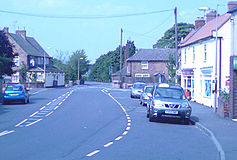South Collingham
| Collingham | |
|---|---|
 The north end of the High Street showing the Grey Horse public house (left), and One-Stop convenience store (right). |
|
| Population | 2,738 (2011) |
| OS grid reference | SK835615 |
| District | |
| Shire county | |
| Region | |
| Country | England |
| Sovereign state | United Kingdom |
| Post town | NEWARK |
| Postcode district | NG23 |
| Dialling code | 01636 |
| Police | Nottinghamshire |
| Fire | Nottinghamshire |
| Ambulance | East Midlands |
| EU Parliament | East Midlands |
| UK Parliament | |
Collingham is a village and civil parish in Nottinghamshire, England. The population (including Brough) at the 2011 Census was 2,738.
Collingham is located on the banks of the River Trent on the A1133 main road, just off the A46. It is approximately 6 miles (9.7 km) from Newark-on-Trent, 15 miles (24.1 km) from the city of Lincoln, and 28 miles (45.1 km) from the city of Nottingham.
Collingham is close to the old Roman Fort at Brough and there have been several local finds of Roman coins, jewellery and villa remains. It lies close to the Fosse Way on its way to Lincoln. The village name suggests a fairly early Saxon foundation, preceding the occupation of eastern England by the Danes and it is naturally mentioned in the Domesday Book. It is thought that the Great North Road crossed the Trent here before Newark was founded; prior to the river's change of channel westwards it ran close to the village and was the cause of much flooding. Many of the other villages close by have names which suggest that they were later daughter settlements. It possessed two churches in North and South Collingham from before the Norman conquest. The parishes extended from the river floodplain onto the uncultivated moorland on the higher ground between Trent and Witham, allowing for good grazing and meadowland throughout the year.
In medieval and early modern times Collingham operated an openfield system and enclosure did not take place until the turn of the 18th/19th centuries, changing much local farming from a small holding of strips and the right to extensive grazing, to individual small cottage holdings or a precarious existence as a landless agricultural labourer. The wide square fields and relatively few isolated farms are the result. One field was set aside in the enclosure award of 1790 for lease every year with the revenues being put to the use of the poor of the parish. Around the end of the 18th and beginning of the 19th century there was an influx of agricultural labour, displaced from the enclosures of the upland Lincolnshire villages in places like Boothby Graffoe, Coleby and Harmston, taking the place of former Collingham people who had moved to towns such as Lincoln, Newark and Nottingham in search of better employment.
...
Wikipedia
